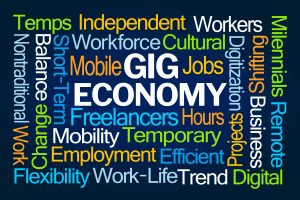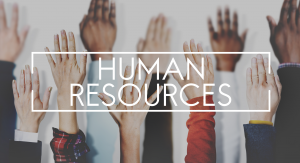
by admin | Jul 2, 2019 | Benefit Management, Human Resources
 By now you’ve heard of the term “gig economy” but you may not know what it means. Is it describing the economy of musicians as they work gigs? Does it mean something about computers and the measurement of space allotted for their programs? Does it have something to do with fishing? Well, not exactly. But, have no fear! We will break this term down into easy bites and you’ll be an expert on the gig economy in no time.
By now you’ve heard of the term “gig economy” but you may not know what it means. Is it describing the economy of musicians as they work gigs? Does it mean something about computers and the measurement of space allotted for their programs? Does it have something to do with fishing? Well, not exactly. But, have no fear! We will break this term down into easy bites and you’ll be an expert on the gig economy in no time.
What IS the Gig Economy?
The term “gig economy” refers to the new landscape of employment in the world where workers are hired for temporary, flexible jobs instead of full-time permanent positions. Think of it this way: workers in a gig economy are paid for completing a job in a predetermined timeframe—like musicians are paid for a night of music (a gig) at a venue. In a gig economy, you see that independent contractors and freelancers tend to be hired over the more traditional, full-time job seekers. Examples of jobs that thrive in this economy are technology-based positions, creative jobs, and the new tide of service-based positions in companies like Uber, Airbnb, and Instacart.
Gig Economy Numbers
Forbes magazine reports that according to the 2018 numbers from the Bureau of Labor Statistics, there are 55 million people in the US classified as gig workers. This is a huge number! In fact, that translates to more than 35% of the current US workforce. Projected to rise to 42% in 2020, over 40% of these workers are estimated to be millennials. As those numbers increase, the proportion of male to female workers shifts. Once right at 50/50, the new ratio is 60/40. This is attributed to larger numbers of women returning to school for postsecondary education. In fact, many leave the workforce completely to return to school versus taking courses and working at the same time.
Pros of Gig Economy Jobs
There are many pros to a job in this category. Job seekers who are looking for gig economy positions name flexible workplaces and flexible hours as their top priorities. The shift to remote offices as well as the freedom to work at whatever hours are most convenient definitely supports this new economy. Employees who have the discipline to manage their workflow and complete tasks on time are ones that will thrive in a gig job. The positives are not limited to just the employees, though. Employers like being able to choose new hires from a much larger pool of candidates because they are not tied down to job seekers in their immediate vicinity. Employers are also able to save money as they do not have to invest in work equipment, health benefits, or on-going training for these independent workers.
Cons of Gig Economy Jobs
The cons of gig work are some of the flip sides to the pros of gig work. These drawbacks include the absence of health benefits and 401k benefits. Freelancers have to buy their own healthcare and figure out their own savings schedule for retirement—both of which aren’t impossible, but they do take up time and tend to be at a greater expense than the benefits offered in a traditional work environment. Gig workers also face the reality of no paid sick days or vacation days. If a freelancer has the flu, he isn’t paid for the time he misses from work and his deadline isn’t adjusted in this task-based economy. On the employer side of the equation, companies report that the pool of qualified candidates for higher level management positions continues to get smaller as the trend for gig workers who freelance from job-to-job increases
The workplace continues to evolve from a traditional 9-5 workday in a traditional office environment to one that is a flexible work cycle in an ever-changing location. Employees place high priority on setting their own rhythm for work flow and prize independence. Employers are encouraged to stay in-tune with the gig economy and to seek ways to marry their company’s needs with the needs of this new workforce population. Both employer and employee can benefit from this new work landscape.

by admin | Jun 20, 2019 | Human Resources
 Every company wants to lead their industry, and doing so means remaining competitive. With the rate of speed the world experiences change in this age that is a very difficult proposition. For an HR professional, it is increasingly more difficult to stay ahead of the curve.
Every company wants to lead their industry, and doing so means remaining competitive. With the rate of speed the world experiences change in this age that is a very difficult proposition. For an HR professional, it is increasingly more difficult to stay ahead of the curve.
So, what are the critical pieces to the strategy?
- Agility
- Change Management
- Culture
Knowing that, how do the three concepts tie to one another?
We start with agility.
When it comes to this part of the strategy, what HR professionals really want is to be able to adjust at a moment’s notice. But it’s not enough to just be able to make the change. The HR professional wants to effectively implement the change in the organization.
Of course, that change doesn’t just happen at the drop of the hat. It requires leadership and even some maintenance.
That’s where change management comes into the mix. HR Exchange Network contributor John Whitaker says:
“Change can and will come quickly. Change management is a helpful (and sometimes hopeful) way to plan the actions and responses needed during a change process. But you must take advantage of those times where you are thrown into a chaotic situation without the benefit of planning.”
Finally, that brings us to culture.
In addressing this concept, CultureIQ worked with Bloomberg to survey 300 senior executives about the Future of Work. In that research, one of the first things they learned is work is becoming more complex. How? Consider first that companies are becoming more agile either by force or organically. Executives know they have to do this in order to remain competitive. Optimizing a talented workforce, predicting talent needs and keeping retention rates high are critical to sustaining your organization’s competitive advantage.
In fact, CEOs recognized that one of the most important factors in their organization’s performance for the next three years was ensuring their organization was agile.
CultureIQ says agility ranked higher than other attributes like collaboration, engagement, or innovation.
A company’s culture is imperative to its strategy especially when you consider this fact: culture influences whether talent is attracted or not attracted to the company. It’s also significant in the company’s ability to retain their best employees.
According to Gallup, 4 in 10 U.S. employees strongly agree their organization’s mission and purpose makes them feel their job is important. Furthermore:
“By doubling that ratio to eight in 10 employees, organizations could realize a 41% reduction in absenteeism, a 33% improvement in quality, or in the case of healthcare, even a 50% drop in patient safety incidents.”
Gallup has studied organizational culture and leadership for years. They find some organizations have difficulty in successfully establishing their “ideal” culture and attribute that to the fact that culture is constantly in flux and is not the same one moment to the next.
Earlier this year, researchers looked specifically at how HR leaders fit into the process of changing culture.
“Our analytics show that in the world’s highest performing organizations, HR leaders play a central role in creating and sustaining the culture their organization aspires to have. As the stewards and keepers of the culture, HR leaders are responsible for inspiring desired employee behaviors and beliefs — and in turn, realizing the performance gains of a thriving culture.
By owning their pivotal strategic and tactical roles in shaping work culture, HR leaders can cultivate exceptional performance and prove to senior leadership that they deserve a seat at the table.”
For HR, Gallup set forth three roles that explain how leaders influence culture.
- Champion – Executive leaders create the vision of the perfect culture, but HR leaders champion it. They are responsible for turning words into deeds.
- Coach – HR leaders, as coaches, make sure managers and employees are on the same page and help the two entities take ownership of the culture.
- Consultant – HR leaders here consistently check culture metrics such as employee engagement, customer outlines and performance indicators. In this way, HR leaders can make sure the culture strategy stays on track.
By Mason Stevenson
Originally posted on hrexchangenetwork.com
by admin | Jun 13, 2019 | Human Resources, IRS
Question: Are amounts an employer reimburses employees for mileage taxable?
Answer: They may be; the type of reimbursement plan will dictate whether reimbursement for business travel is or is not taxable. Both accountable plans and non-accountable plans allow an employer to reimburse employees for their business expenses.
With an accountable plan, the reimbursement is not taxable to your employee. Amounts paid under an accountable plan are not wages and are not subject to income tax withholding and payment of Social Security, Medicare, and Federal Unemployment Tax Act (FUTA) taxes. Your reimbursement or allowance arrangement must meet all of the following conditions in order to quality as an accountable plan:
- There must be a business connection to the expenditure. This means that the expense must be a deductible business expense incurred in connection with services performed as an employee of the employer. If not reimbursed by the employer, the expense may be deductible by the employee from their taxable income.
- There must be adequate accounting by the employee. This means that the employee must give their employer a statement of expense, an account book, a diary, or a similar record in which they entered each use at or near the time it occurred, along with date, mileage, and the business purpose of the use.
- Excess reimbursements or advances must be returned within a reasonable period of time.
A non-accountable plan does not meet the three requirements for accountable plans and is subject to all employment taxes and withholding. Payments under a non-accountable plan occur if: (1) the employee is not required to substantiate expenses with receipts or other documentation in a timely manner; and (2) the employer advances an amount to the employee for business expenses and the employee is not required to, and does not, return any amount he or she does not use for business expenses in a timely manner.
Employers should also check with their state department of taxation to understand any state tax rules applicable to them.
For more detailed information on federal mileage reimbursement, see the IRS page containing Publication 463, Travel, Entertainment, Gift, and Car Expenses, and updates to this publication since its publication date.
Originally posted on ThinkHR.com

by admin | May 14, 2019 | Employee Benefits, Human Resources
 While more and more perks — catered lunches, on-site gyms, immunizations programs — are about employee health, wellness, and happiness, they ultimately are also designed to keep workers at work. A recent article in Quartz at Work points out that more than anything, employees want more time off and out of the office. Unlimited time off, to be exact.
While more and more perks — catered lunches, on-site gyms, immunizations programs — are about employee health, wellness, and happiness, they ultimately are also designed to keep workers at work. A recent article in Quartz at Work points out that more than anything, employees want more time off and out of the office. Unlimited time off, to be exact.
Once the perk of tech firms and startups, more companies are beginning to explore unlimited paid time off. And, though still rare at only one to two percent of companies, it’s a popular request in part because workforce demographics continue to shift. Nearly half of employees are Millennials, whose priorities are changing the benefits conversation. For this group, finding more balance and having more control of their time are key. In part, this may be because time off has fundamentally changed. Well and Good looks at the fact that, with near-constant connectedness, vacation days often still involve checking email and getting other notifications.
Add to that cultural and workplace expectations of accessibility and availability, and workers are at risk for burnout. One in four workers report feeling burned out all the time and almost half feel burned out sometimes. This burnout can cost employers in lost productivity, and employees in terms of health and happiness. Today, someone doesn’t need to psychically spend 90 hours a week at the office to be working 90 hours. With our always-on lives, restorative time off is rarer but still as important to prevent burnout.
That doesn’t mean every business is jumping on the unlimited time off bandwagon. Want other ideas? A writer for The Guardian suggests a middle ground, with more days off the longer an employee has worked at a company. And, while rollover sounds generous, it may make employees less likely to use it. Want to give it a try but concerned about misuse? Business Management Daily suggests it’s also more than reasonable to consider limits on unlimited and critical to set sound guidelines around pay as well as whether days off can be all in a row.
For many employees, unlimited time off offers the extra flexibility for life’s challenges and can aid satisfaction and retention. Before HR Departments worry the system will be abused, research shows that people take significantly less time off when it’s unlimited. In fact, what may be more impactful is a minimum number of days off may be required so as to ensure employees take advantage of a benefit meant to restore and replenish their energy, creativity, and engagement. To work, it needs to be modeled by managers and other higher-ups, as a CEO details in a Chicago Daily Herald article.
By Bill Olson
Originally posted on ubabenefits.com

by admin | May 2, 2019 | Human Resources
 2019 has ushered in many new trends such as retro cartoon character timepieces, meatless hamburgers, and 5G networks to name a few. Not surprisingly, trend-watching doesn’t stop with pop culture, fashion, and technology. Your company’s human resources department should also take notice of the top changes in the marketplace, so they are poised to attract and retain the best talent. These top trends include a greater emphasis on soft skills, increased workforce flexibility, and salary transparency.
2019 has ushered in many new trends such as retro cartoon character timepieces, meatless hamburgers, and 5G networks to name a few. Not surprisingly, trend-watching doesn’t stop with pop culture, fashion, and technology. Your company’s human resources department should also take notice of the top changes in the marketplace, so they are poised to attract and retain the best talent. These top trends include a greater emphasis on soft skills, increased workforce flexibility, and salary transparency.
SOFT SKILLS
Gone are the days of hiring a candidate solely based on their hard skills—their education and technical background. While the proper education and training are important factors in getting the job completed, a well-rounded employee must have the soft skills needed to work with a team, problem solve, and communicate ideas and processes. According to Tim Sackett, SHRM-SCP and president of HRU Technical Resources in Michigan, “Employers should be looking for soft skills more and training for hard skills, but we struggle with that.” While hard skills can be measured, soft skills are harder to quantify. However, soft skills facilitate human connections and are the one thing that machines cannot replace. They are invaluable to the success of a company.
WORKFORCE FLEXIBILITY
As millennials begin to flood the workplace, the traditional view of the workweek has changed. Job seekers report they place a high importance on having the flexibility of when and where to work. The typical work day has evolved from a 9am – 5pm day to a flexible 24-hour work cycle that adjusts to the needs of the employee. Employers are able to offer greater flexibility about when the work is completed and where it takes place. This flexibility has so much importance that job seekers say remote work options and the freedom of an adaptable schedule have a higher priority to them over pay.
SALARY TRANSPARENCY
In the wake of the very public outing of the gender and race pay gaps, companies are opening up conversations about wages in the workplace. Once a hushed subject punishable by termination, salary information is now often being shared in the office. Employers have found that the more transparent and open that they are about the compensation levels in their organization, the more trustworthy they appear to their workforce. One way to stay educated on the welcome trend of pay equality is to visit the US Bureau of Labor Statistics’s website to review wage ranges across the nation. Another great resource is the Department of Labor’s free publication called “Employer’s Guide on Equal Pay.”
By watching the trends in the marketplace, employers can focus on what is important to their staff. Honest discussions about salary and compensation, when and where to work, and developing the employee as a whole, including soft skills, sets your company up for success. When you listen to what the market is saying, you show you are sensitive to what their priorities are—and this is always on trend.

by admin | Mar 20, 2019 | Compliance, Human Resources
 Even when you proactively anticipate all the people risks that have the potential to impact your workplace, it’s easy to convince yourself there is no risk to you — that it will never happen here.
Even when you proactively anticipate all the people risks that have the potential to impact your workplace, it’s easy to convince yourself there is no risk to you — that it will never happen here.
You may think no one at your workplace will harass anyone, no one will sue you over an honest mistake made in administering workers’ comp, no one will accidentally cause a data breach, or no one will ever bring a weapon to the office. You might think managing people risk is extremely time consuming and not worth the effort. Rationalizations like this may lead you to believe you don’t need to do anything to prevent these risks.
However, these risks are very real and can happen anywhere, at any time. It’s imperative you cover all of your bases, and it’s actually very straightforward, especially if you have a partner on your side.
Ideally, you will integrate people risk management (PRM) with your business practices so it’s not something extra to do; it’s a way of doing things you already do. PRM can be a lens through which you look through when evaluating your policies, procedures, and other aspects of how you run your company.
Acknowledging and Preventing Risk: A Four-Step Plan
When you are anticipating risk, you are thinking about what might happen. Then you need to look at what you should do when something actually happens and it’s time to acknowledge the risk.
Maybe a law passes or regulation is finalized, you realize your pay policies are not in compliance with the law, or an employee informs you they have been prescribed medical marijuana but you have a very strict drug use policy. What tools to do you have to deal with that?
Once you acknowledge the risks inherent in these issues, there are four steps to putting a plan of action into place to prevent the risks from causing damage to your company’s bottom line, its reputation, or to its level of employee engagement:
- Understand when and how the risk will impact you. If it’s a law or regulation, when does it go into effect? Is it an ongoing issue or something that can be addressed and then set aside? What are the potential penalties or pitfalls presented by the risk?
- Determine the best course of action. Does the situation require simple changes to operations or a more complicated approach? Where do changes need to be implemented — in handbook policy updates, procedural documentation, or new training programs?
- Craft communication strategies around the risk. Who needs to know what, and how much information should be given to people at each level? What information should be held back to preserve confidentiality? What information is only relevant to a handful of people (such as when an OSHA report is due) and what information is relevant to everyone (such as who needs sexual harassment training in your state)?
- Decide what change management activities are required to get buy-in. It’s one thing to decide to do something but getting people ready to embrace the change is another thing. If change management is good, then the changes will take hold, the implementation will be smooth, and the risks will be lower.
by Larry Dunivan, CEO of ThinkHR
Originally posted on ThinkHR.com

 By now you’ve heard of the term “gig economy” but you may not know what it means. Is it describing the economy of musicians as they work gigs? Does it mean something about computers and the measurement of space allotted for their programs? Does it have something to do with fishing? Well, not exactly. But, have no fear! We will break this term down into easy bites and you’ll be an expert on the gig economy in no time.
By now you’ve heard of the term “gig economy” but you may not know what it means. Is it describing the economy of musicians as they work gigs? Does it mean something about computers and the measurement of space allotted for their programs? Does it have something to do with fishing? Well, not exactly. But, have no fear! We will break this term down into easy bites and you’ll be an expert on the gig economy in no time.



